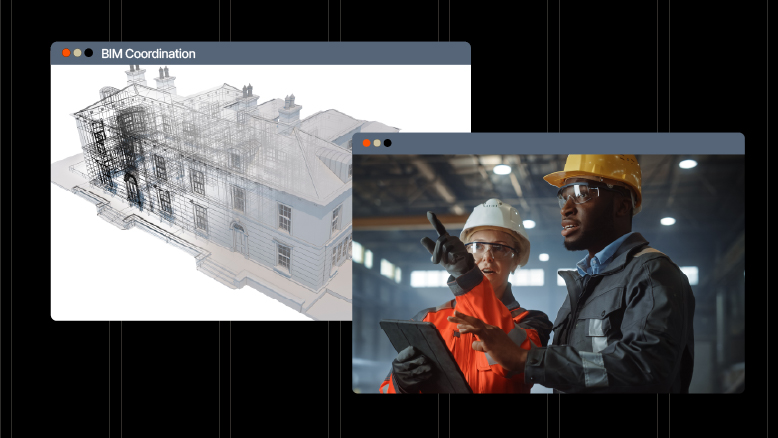— 6 min read
Mitigating the Impact of Tariffs in Construction
Last Updated Apr 24, 2025
Last Updated Apr 24, 2025

The construction industry faces constant financial uncertainty, and the 2025 escalation of global tariffsmandated by executive order drew attention to their potential impacts. While no crystal ball can tell exactly when they will go into effect, how long they will last or how much they will fluctuate, one thing is certain: Tariffs can affect the industry in the form of increased material costs, supply chain disruptions and general market uncertainty.
Owners and contractors are already implementing reactive solutions to mitigate risk in the short term. At the same time, companies need to explore proactive strategies that help ensure long-term success — regardless of external market factors.
Table of contents
Reactive Approaches (Short-Term Solutions) to Tariffs
The possible problems caused by tariffs — specifically as they relate to cost and delivery of materials — is not entirely new to the industry. During the COVID-19 pandemic, several traditional mechanisms were enacted to protect upended projects.
Engaging in reactive approaches to mitigating the effects of tariffs may prove useful, but it’s important to weigh the pros and cons of each.
| Reactive Approach | Pros | Cons |
|---|---|---|
| Escalation Clauses | By contractually setting a clear mechanism for adjusting prices in the event of a shift in material cost, escalation clauses provide protection, budget certainty and a sharing of overall project risk. | This can create an adversarial environment during contract negotiation. The lack of specifics (such as exact dates, times, percentages or locations of downstream cost increases) will make it difficult to set definitive terms and establish clear triggers. |
| Stockpiling Materials | Buying materials in advance and in bulk can secure supplies for multiple projects, avoid delays and lock in prices to protect Guaranteed Maximum Price. | Unexpected costs from the risk of damage, remediation or a shift in design can accumulate, as can the loss of jobsite space or storage costs. |
| Construction Delay Claims such as Force Majeure | Provides protection against unforeseen events, and can give negotiating leverage to push risk elsewhere as well as provide temporary relief. | As more time passes and more tariffs are discussed, it will be difficult to argue that tariffs on materials qualify as "unforeseeable." |
Proactive Approaches (Long-Term Solutions) to Tariffs
The uncertainty caused by tariffs necessitates proactive strategies that go beyond these immediate solutions. By thoughtfully leveraging collaborative contracts and maintaining accurate, up-to-date data, stakeholders at all levels from the top down can work together to build upon lessons learned and navigate future challenges with greater flexibility.
Collaboration and Communication
Employing business practices that encourage collaboration and communication can create trust between teams. This can lead to greater stability and counteract the volatility of the moment.
Build strong partnerships.
Owners attempting a design-bid-build project during such volatile times are likely to face challenges. That’s why partnering early with groups that possess the necessary insights and data is important. The lowest bid isn’t always the best partner. Hiring the right GC that has the best insight and also the best relationships with trade partners who in turn take part in the collaborative delivery from the start aligns expectations and realities.
Use collaborative delivery methods.
When engaging in these principles it is important to make sure all contracts reflect the same commitment to collaboration in their structure. The focus should shift from transferring risk (through blanket escalations and delay clauses) to sharing success.
When your contract structure incentivizes you to help the other team win, you are ready to bring your insights to the table. This creates a win-win situation for everyone involved.
Mason Finley
Strategic Industry Advisor, Preconstruction
Procore
Empower trade partners.
Flexibility only happens when people have the information they need to be flexible. If owners can share their needs downstream, then the flow of information upstream should be welcomed. When trades see a spike in prices or contractors see delayed lead times, they can share that information so that at every step of the way considerations of which avenue to pull from: cost, quality or time.
Embrace a flexible mindset.
Traditional methods may not always work in non-traditional times. A flexible mindset can be employed by partners early on in the process to encourage better forecasting, pricing and procurement practices.
Clients often want to lock in a Guaranteed Maximum Price during design development at around 60% completion so we can start procurement. As a GC, the longer we can wait for design completion the more we’re able to send complete packages to my trades for accurate pricing and faster turnaround, which leads to greater certainty, fewer change orders and reduced risk for everyone involved.
Mason Finley
Strategic Industry Advisor, Preconstruction
Procore
Creativity: There’s always more than one way.
Certainty of delivery is necessary, but when supply chain disruptions threaten the materials needed to deliver that certainty flexibility needs to transition to creativity. Estimators should be prepared to bid a project with different options that still achieve the final goal, as owners may request this.
Asking the question “how else can we satisfy design” or using Target Value Design to consider what other materials or sources are available will help reduce the onsite volatility tariffs could create.
Build a Strong Foundation with our Preconstruction Course
With 20+ years of experience, Ben Ashburn teaches you how to streamline planning, bidding, and procurement for better outcomes.

Making Data-driven Decisions
Analytics possess the power to identify trends, leverage data and gain clarity from market insights. They can be used to form learning patterns that can improve any project regardless of circumstance.
Analytics will be the go-to when it comes to identifying patterns so the decisions you make going forward are better informed.
Bruno Pasini
Senior Solutions Engineer, Overlay, PM & Preconstruction
Procore
Track and use historical data.
Any estimate is a combination of historical costs that need to be normalized to fit today or projected to fit the future. Taking the time to find and catalogue previous project costs will only strengthen the financial story that satisfies all parties.
Stay up-to-date on current pricing.
Tracking and cataloguing fluctuations in material costs on a regular basis allows greater precision when it comes to bids and procurement.
Get all data — not just costs.
Creating logs that track lead times of key equipment and building materials most sensitive to changes in the market. Then, for example, if a GC is asked why a necessary material is 20% above the current market, they can present a clear and well-founded response. This kind of clarity and transparency builds trust — and that’s an important component between parties when things get difficult.
Cross-reference everything.
Taking the time to put the data together allows for thinking outside the immediate problem. Consider integrating procurement logs and cashflow, for example, so that tracking internal funds needed at earlier points won’t come as a surprise. Using all data points becomes a safety net for every stakeholder on a project from owner down.
Utilize software purpose-built for construction.
Information duplicated across isolated solutions leaves too much room for error. Pulling from various programs like Excel, P6 or Microsoft Project is inefficient. By creating a single source of truth for project data helps make procurement predictions and supply tracking easier for all project stakeholders to access.
An investment in project management software is an investment in communication and collaboration that can make moments of uncertainty easier to navigate.
In stable times there is still relatively little we can know for certain about the future. When dealing with unexpected complications a proactive, holistic, data-driven approach is so important. It enables stakeholders on any project to communicate truthfully, set realistic expectations and protect the project timeline in the onset of uncertain times now or in the future.
Was this article helpful?
Thank you for your submission.
0%
0%
You voted that this article was . Was this a mistake? If so, change your vote here.
Scroll less, learn more about construction.
Subscribe to The Blueprint, Procore’s construction newsletter, to get content from industry experts delivered straight to your inbox.
By clicking this button, you agree to our Privacy Notice and Terms of Service.
Categories:
Tags:
Written by
Mason Finley
Mason Finley is a Strategic Industry Advisor in Preconstruction at Procore Technologies in Austin, Texas. With over a decade of experience, he has advanced from Preconstruction Manager to Director at Ryan Companies US, Inc. Mason has also held key roles at Aspen Heights and SpawGlass, focusing on project management and preconstruction. In addition to his industry expertise, he has served in leadership roles at The Austin Stone Community Church, contributing to community development.
View profileBruno Pasini
Bruno Pasini is a Solutions Engineer at Procore, where he develops new tools to simplify and streamline the preconstruction process. He spent nearly 20 years as an estimator and project manager for general contractors and specialty contractors in New York and California. He currently lives in San Diego.
View profileJonathan Greene
on Greene is a freelance educator, writer, and award winning theater maker. As an educational writer he has created content, lessons, and led seminars for Young Audiences of Louisiana, Hynes Charter System in New Orleans, Centre Stage School of the Arts in Singapore, 'Friends of The Museum' Docent Workshop in Singapore, The Prague Public High School System, Moleac Pharmaceuticals, and with the Grand Portage Ojibwa Tribe. His work and writing for theater has been featured in Howlround and American Theater Magazine and he is the recipient of 2 regional theater awards in his home of New Orleans. He is a BFA Graduate of Boston University and a previous Kennedy Center Fellow.
View profileExplore more helpful resources

Using Construction Benchmarking for Better Project Outcomes
Successful construction teams consistently work toward getting better at what they do — producing better quality projects, reducing waste and delivering work on time and on budget. Construction benchmarking provides...

How to Understand and Use Architect’s Supplemental Instructions
Architect’s supplemental instructions, also known as ASI, offer a means of making small changes to the construction contract after it’s signed. The ASI is a document issued by the architect...
Improving Project Monitoring with Construction Quantity Tracking
Once a construction project is underway, builders need to closely monitor the project’s progress and make sure it’s staying on schedule and within budget. Quantity tracking helps construction leaders manage...

Streamlining Construction Projects with Effective BIM Coordination
The old saying goes: if you fail to plan, you plan to fail. Construction professionals know this better than nearly anyone. To take a project from a vision in an owner’s...